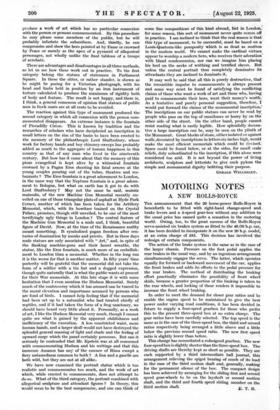MOTORING NOTES
A NEW ROLLS-ROYCE
THE announcement that the 20 horse-power Rolls-Royce is henceforth to be fitted with right-hand change-speed and . brake levers and a 4-speed gear-box without any addition to the usual price has caused quite a sensation in the motoring world. Owing, too, to the great success of the Rolls-Royce servo-assisted six brakes system as fitted to the 40/50 h.p. car, it has been decided to incorporate it on the new 20 h.p. model,' at an extra charge of £85. This decision has involved the redesign of certain components.
The action of the brake system is the same as in the case of the larger chassis. Pressure on the foot pedal applies the rear brakes in the usual way, and by an ingenious arrangement- simultaneously engages the servo. The latter, which operates equally for forward or backward movement of the car, applies the front brakes and adds its efforts to the pedal pressure for the rear brakes. The method of distributing the braking effort practically eliminates the possibility of front wheel' skids, because a greater proportion of the braking is taken to the rear wheels, and locking of these renders it impossible to increase the front wheel braking.
In order to meet the demand for closer gear ratios and to enable the engine speed to be maintained to give the best power under varying road conditions, it has been decided in • future to supply a four-speed gearbox for those who prefer this to the present three-speed box at no extra charge. The gear ratios have been carefully selected. The top speed is the same as in the case of the three-speed box, the third and second ratios respectively being arranged a little above and a little below the previous second speed ratio. The new first speed ratio is slightly lower than before.
• This change has necessitated a redesigned gearbox. The new four-speed box is slightly shorter than the three-speed box. The- driving shafts are thereby kept as short as possible. They are each supported by a third intermediate ball journal, this arrangement relieving the spigot bearing of much of its load in the case of the third motion shaft and, generally, making for the permanent silence of the box. The compact design has been achieved by arranging for the sliding first and second speed gear-wheels to be on the layshaft or second motion shaft, and the third and fourth speed sliding member on the third motion shaft E. T. B.


































 Previous page
Previous page